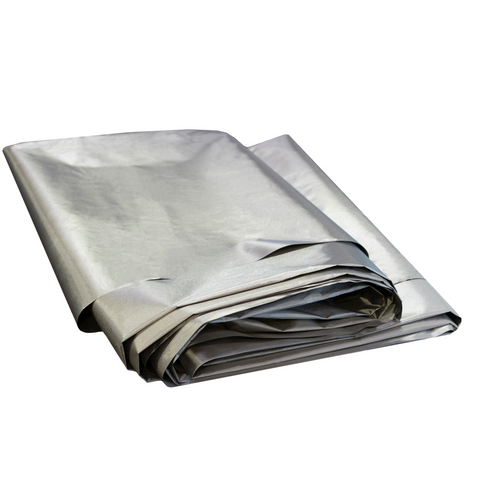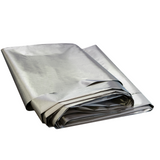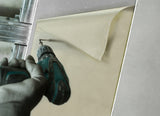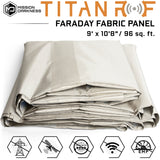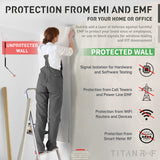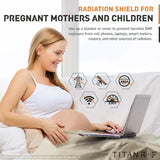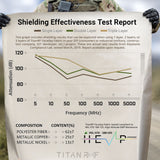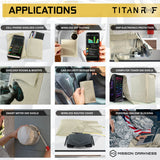FINAL SALE: *Faraday Fabric Panel is nonrefundable unless return is due to a manufacturing defect or product hasn’t been touched and is in unopened packaging.
If you are unsure of how to use the fabric for your project, contact us for tips tailed to your application.
- DESCRIPTION
- SPECS
- USAGE
USE TITANRF™ FARADAY FABRIC PANEL TO CREATE AN RF SHIELDING ROOM OR ENCLOSURE
The Mission Darkness TitanRF™ Faraday Fabric Panel is a 10.66ft x 9ft (96 sq ft) rectangular sheet that can be applied to a wall or used to create a radio frequency (RF) shielding enclosure. The fabric uses a copper and nickel composition to block WiFi (2.4 & 5GHz), Bluetooth, cell signals including 5G networks, GPS, RFID, NFC, and radio signals from low MHz all the way up to 40GHz. This is the same fabric that is certified to military standards MIL STD 188-125, as well as IEEE 299-2006. The lab certifications not only. This compliance measure not only ensures that the fabric shields against high-altitude electromagnetic pulses (HEMPs) and related occurrences, such as coronal mass ejections (CMEs), electrostatic discharges (ESDs), and solar flares, but provides concrete proof to the shielding ability and effectiveness of the fabric. It is primarily used by military and law enforcement forensics investigators to isolate devices, as well as used by civilians for harmful EMF radiation reduction, EMP protection, digital privacy, signal isolation in secure facilities, RF isolation for hardware and software testing, and more.
The panel is constructed out of three 9ft length by 44in width TitanRF Faraday Fabric sheets slightly overlapped and connected using 2.5in width TitanRF Faraday Tape on both the front and back sides (see images below). We assembled a full panel to eliminate the hassle of having to connect sheets on your own, for wall coverings, shielding extra-large electronics, and related applications. It can be cut, sewn, glued, or taped to various surfaces for creating faraday tents, cages, or RF shielding enclosures. If using in construction applications, it can be applied directly to a surface, such as a room wall, in between sheets of drywall, over building materials and tent frames, etc. If connecting multiple fabric panels, slightly overlap edges, and use TitanRF Faraday Tape (available in various lengths and widths) to tape together. Once the panel is fully enclosing an electronic device, you can use a faraday testing app, communicable device, or signal analyzer to confirm your design is effectively shielding. A booklet with helpful construction tips and usage instructions is included. Read our TitanRF Faraday Fabric FAQ for answers to commonly asked questions regarding using the material for faraday cages and RF shielded enclosures.
SKU: MDFF-PANEL
FEATURES
- High shielding (not mid-grade shielding) material for blocking RF signals such as WiFi, cell signals including 5G networks, GPS, Bluetooth, RFID, NFC, and radio signals from low MHz to 40GHz
- EMI, EMR, and EMF shielding
- Polyester fiber, metallic copper, and metallic nickel composition
- Lab tested and certified MIL STD 188-125 (compliant for high altitude EMP resistance), as well as IEEE 299-2006 (shielding effectiveness standards)
- Surface resistance approximately .5 Ohm/sq
- Lightweight and extremely durable
- High grade corrosion and tarnish resistance
- Easy to work with - cut, sew, tape, glue, and use like standard fabric in your industrial (military, construction company, IOT developer, etc.), or DIY (consumer) project
- Simple to apply to a wall or incorporate into construction projects for building signalproof rooms and tents (read details below)
TECHNICAL DETAILS
- Fabric type: nickel copper stretchable conductive fabric (woven)
- Ingredients: 74% polyester, 22% nickel, 4% copper
- Resistance (MΩ): ≤10
- Thickness (um): 180±20
- Width (mm): 1,115±10
- Weight (G/㎡): 78±5
- TD tensile resistance (Kgf/5cm): 50±5 (N/1CM)
- MD tensile resistance (Kgf/5cm): 85±5 (N/1CM)
- TD tensile strength (MPa): 28±5
- MD tensile strength (MPa): 45±5
- TD elongation (%): 45±5
- MD elongation (%): 30±5
- Attenuation: >65dB
DIMENSIONS
- 10'8"W x 9"H — (96 sq ft)
- 3.25m x 2.75m — (8.92 sq m)
Contact us for a quote if you need custom dimensions or a full fabric roll.
HOW THE FABRIC PANEL IS CONSTRUCTED
WHY IT'S DIFFICULT TO CONSTRUCT A PANEL ON YOUR OWN
- Generally requires two people for assembly
- Large flat and clean environment preferred
- Fabric creases easily
- Conductive tape is difficult to adhere evenly
*Overall combining multiple fabric sheets can be time consuming and tedious, which is why we constructed a solution for shielding large spaces or items
TESTING COMPLETED BY KEYSTONE COMPLIANCE, AN ACCREDITED REGULATORY COMPLIANCE LABORATORY
The shielding effectiveness tests were conducted by Keystone Compliance, a full-service regulatory compliance laboratory offering solutions for nearly all EMC/EMI, environmental, ISTA-certified package and ingress protection testing requirements. The purpose of the tests were to determine the material's ability to reduce the electromagnetic field in a space by blocking the field with barriers made of conductive and/or magnetic materials.
MIL STD 188-125 — TESTED MARCH 27, 2019
Multiple MIL STD 188-125 shielding effectiveness tests were performed to conclude that TitanRF Faraday Fabric is certified "compliant" for High-Altitude Electromagnetic Protection for Ground Based C4I Facilities. The results ensure that the material surpasses military shielding requirements to handle natural or man-made EMPs.
We tested single, double, and triple fabric layers to understand how fabric layering relates to the increase in signal attenuation. The graph above shows the shielding effectiveness results of various layers. *This should be taken into consideration when building your own faraday enclosure, to ensure that you are using enough layers for specific attenuation needs.
The frequency range investigated and all test results are noted in the report generated by Keystone Compliance.
IEEE 299-2006 — TESTED OCTOBER 7, 2020
IEEE 299-2006 is the primary method for measuring the effectiveness of electromagnetic shielding enclosures and materials. The testing conducted was designed to accomplish the following three goals:
- The first goal is to keep certain RF signals within the enclosure of the device.
- The second goal of shielding effectiveness testing is to block external EMI from impacting the device under test.
- The third objective is a combination of the two. A properly-shielded device will effectively retain all RF energy in its enclosure and keep all external RF isolated.
We tested single and double layers of TitanRF Faraday Fabric to understand how layering relates to an increase in signal attenuation. The frequency range investigated and all test results are noted in the report generated by Keystone Compliance.
VIDEO DEMO
Watch the video to see how how large the TitanRF Faraday Fabric Panel is when draped over an object. The considerable size of the panel allows the user to effortlessly cover a wall or extra-large object.
FREQUENTLY ASKED QUESTIONS
The "Do-It-Yourself" shielded enclosure FAQ page includes answers to frequently asked questions and best practices related to using Mission Darkness TitanRF Faraday Fabric for building RF shielding enclosures.
SAFETY
TitanRF Faraday Fabrics, tapes, and other products including these items are made with metals such as copper and nickel. As such, they are conductive and also flammable. Keep these items away from outlets, plugs, cables, and any sources of electricity to reduce the chance of fire. Contact us if you have questions or concerns about your project. Wear gloves when handling if your skin is sensitive to nickel, copper, or polyester.
California Proposition 65 Warning: This product contains chemicals known to the state of California to cause cancer and birth defects or other reproductive harm.
PRIMARY APPLICATIONS
- Signalproof rooms, tents, and cages
- Radiation shielding curtains, blankets, etc.
- Shielding electronics from RF signals
- Signal isolation
- Defense against EMPs and related occurrences
- Protection against EMF, EMR, and EMI
- Data security
- Secure facilities
- Digital privacy
OTHER APPLICATIONS
USING TITANRF™ FARADAY FABRIC PANEL + ADDITIONAL MATERIALS IN CONSTRUCTION PROJECTS, FARADAY ROOMS & TENTS
TitanRF Faraday Fabric Panel can be used for constructing signal proof rooms and tents. In order to create a fully shielded room, there cannot be any opening or holes, otherwise signal may penetrate. We recommend using two layers of the fabric panel on the floor, ceiling, and walls, ensuring that the material is overlapping on all sides and seams. *Construction instructions are highly dependent on your specific application, and will vary depending on the size and type of room.
-
- You can use various construction methods to line the walls of your room or enclosure with TitanRF Faraday Fabric. Methods include placing the fabric between drywall, gluing it with a general contact adhesive (apply a thin layer and avoid using heavy adhesive), using TitanRF Faraday Tape to tape it in place or connect multiple fabric sheets, etc. Driving screws through the fabric may or may not be acceptable (use sparingly).
- For inhabitable faraday rooms or tents, you may need to incorporate additional components such as EMI/RFI shielded vents, windows, filters, etc., as well as a signal proof doorway. *Read the construction section on the TitanRF Faraday Fabric page for more detailed information.
COMPLETE YOUR PROJECT WITH TITANRF™ FARADAY SUPPLIES
Use additional TitanRF faraday supplies for the construction of your EMI/EMR reduction project or RF shielding enclosure. TitanRF Faraday Fabric (separate from the panel) can be purchased by the yard and in various lengths. This allows you to purchase the exact amount of material needed for your project. TitanRF Faraday Tape is available in multiple lengths and widths, and can be used to connect multiple fabric sheets or panels, seal enclosures, mend punctured fabric, and more. Additional RF shielding materials include patches and foam gaskets.


